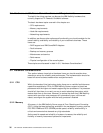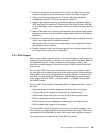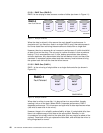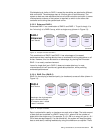42 J.D. Edwards’ OneWorld B73.3 and Windows Terminal Server
is performance degradation when one disk fails. However the disk can be
replaced, the missing data restored and performance returned, automatically
when a hot-spare disk is a part of your configuration or manually when a failed
disk has to be physically replaced.
The major advantage of RAID 5, is its ability to keep the system up and running in
the event of a disk failure, no down time, no loss of data with a single disk failure.
However, where as in RAID 0, RAID 1, and Enhanced RAID 1, the loss of a single
disk may require a reboot of the system; in RAID 5 it does not. This is a major
advantage when there is a need to keep the data available to endusers and
customers for long periods.
5.2.5.5 IBM ServeRAID Adapters
Today’s business critical data grows at an alarming rate. A few years ago a
database of around 20 GB would have been considered large, even beyond the
scope and capacity of all but the largest of mainframes.
Today, databases of around 20 GB are very normal, and nothing out of the
ordinary. It is databases of 1 or 2 terabytes that are seen as incredibly large.
So what growth rate can you expect from your customer’s database?
The answer is unpredictable, but one point is certain, and that is, grow it most
certainly will. If you have a system that will handle up to 100 GB of hard disk
today, but you require only 60 GB, your customer will buy 60 GB of hard disk.
Sometime in the future, your customer will want to expand, or concentrate some
of his data, into smaller more manageable sizes. The challenge is to achieve this
data without losing availability to endusers.
So how can this be achieved? Until recently, we had to:
1. Back up all the data.
2. Redefine the disk arrays, or install larger disks and redefine the arrays.
3. Restore the data.
This is an expensive way of growing a database. In today’s environment this
would be unacceptable within a 24x7x365 operation.
The IBM ServeRAID adapter has the answer to this. To grow the database as
mentioned above from 60 GB to 100 GB, you would simply insert more hard
disks, and migrate or "grow instantly" the disk space available to the operating
system, by increasing the size of the array that is already in use, without any loss
of service to endusers.
With IBM ServeRAID adapters, you can migrate the data in a variety of ways. The
options are:
• From RAID 0 to RAID 5
• From RAID 5 to RAID 0
• From RAID 1 to RAID 5
• From RAID 5 to RAID 5 (array expansion)
This functionality of the IBM ServeRAID adapter is known as Logical Drive
Migration (LDM) and is available as standard with all current IBM ServeRAID


















